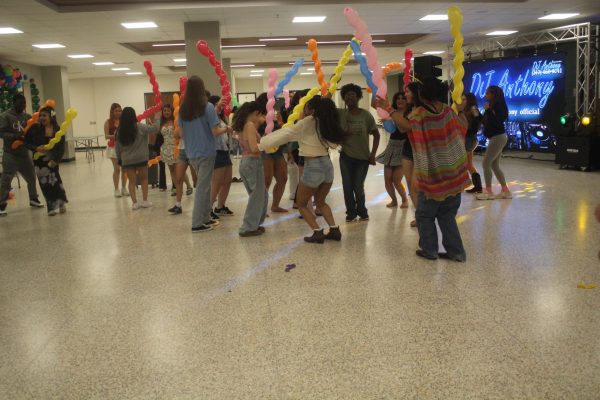Student Stress
Canvas. Chromebooks. Smart boards. This is the epitome of the digital age and it has come to conquer schools. Its tyranny has now forced students to face a new epidemic: stress. According to TheNationalStudent, 82 percent of students are suffering from stress and anxiety. Drowning in assignments, fatigued by screen staring for hours, brain fried for multitasking, and guilty for cheating in the face of desperation the new age of students is crippled rather than aided by technological advancement. As academics have adapted to the digital age, students are overwhelmed with the shift in workload and are now suffering further stress from the consequences of technological advancement.
Due to the efficiency provided with school technology, teachers and administrators find it easier for students to manage a larger workload and complete a larger set of tasks in the same amount of time. With screens and the internet at a student’s disposal, students have access to an abundance of resources just at their fingertips. Because of this easy access, teachers believe students need more comprehensive assignments to ensure they are actually learning and processing information rather than simply writing out the first answer spit out by Google. Although this may seem fair to counteract the superficiality of Google and Wikipedia learning, this expectation is what has largely contributed to the influx in student stress in recent years.
This new adaptation to learning forces students to multi task.Students must juggle a variety of tasks such as researching, processing connections and preparing original work. Students are expected to complete all that in the same amount of time a teacher would have assigned a traditional written task. Online assignments are automatically deemed as simple or fast due to their digital nature, but this is a common misconception. It can take students the same amount of time to complete an online task or a written one depending on the assignment. The diversity of resources offered by technology also lends itself to multitasking by offering efficient ways to view information. This may not seem negative, but when a student is listening to a video, reading an article, writing a comprehensive answer and flipping back to canvas instructions it can be a lot for a brain to process at once especially with the pressure of a time limit. When demands exceed the capabilities of a student it causes stress. The capability of a student doesn’t refer to their work ethic or potential but maybe their weakness and lack of knowledge in a subject at the time of a given assignment. With a completely new subject or topic it’s harder for students to process and form connections while multitasking. Are they really getting the comprehensive learning these assignments are meant to ensure and offer or are they merely executing survival tactics to keep their head above water?
Expectations are very different in our present system of education. Many educators fail to remember that students have more than one class. Demands constantly exceed capabilities in every class. The digital expectations are growing as administrators force new methods of learning down the throats of students and educators. The dependable methods of traditional learning are waning and fading out over time as new technology is introduced.The stress put on students with multitasking and an increase in workload within multiple classes as well as at home takes a risky toll on the mental health of students. It’s hard to keep up. The digital wave of expectation not only affects students who suffer a lack of motivation and struggle with attention, but also affects your highest achievers who can’t take a B. The over saturation of work through technology feeds a lack of motivation in students who don’t care about their academics and those who do, are becoming more and more desperate to accommodate and adapt to these new demands which causes extreme stress and severe mental health risks. This causes negative consequences like an influx of cheating, from pressured students who feel like they don’t have options. In some aspects technology actually makes it easier for students to cheat in school, by offering answers with a mere click or switch of a tab. It’s hard for students to survive in this climate of pressure and stress. It has forced and cornered capable students.Cheating isn’t a matter of immorality these days it’s a matter of survival.
Digital monitoring also increases stress in students. The days of “my dog ate my homework,” are gone in today’s technologically advanced society. There’s no place for such excuses when every essay is typed in google docs, or every assignment is time stamped and scanned through Turnitin.com. With the added work students face today they also face added accountability. Digital assignments are all time stamped which pressures students to make sure all assignments are turned in at a specific time. Deadlines are important and can be positive, but with the added pressure, multitasking, and heavy workload the time stamp simply increases pressure. Teachers now have access to a variety of digital monitoring tactics which overarchingly exerts tighter control over students. It’s difficult as it is for students to balance this workload, but digital monitoring is like caging these students with added pressure. It feeds into stress immensely. Students don’t feel they have freedom or space to learn. How can they if they are so confined by a computer or website and are overwhelmed with the amount of work? This is completely ignoring a student’s commitment to extracurriculars, employment and family responsibility. An adolescent brain can only be overwhelmed so much before they hit a breaking point.
In any aspect the new innovative approach to education has led to significant student stress that is detrimental to academics, mental health and even character. It is the responsibility of educators to be aware of how these changes have an effect on students and make decisions to accommodate these arising issues. If as a society we continue on this same path, we are harming and sacrificing our next generation of student. Administrators and educators must consider the effect their curriculum and plans have on students. We have the power to adapt to the new forefront of educational innovation, but in order for us to adapt it is important to be aware.












